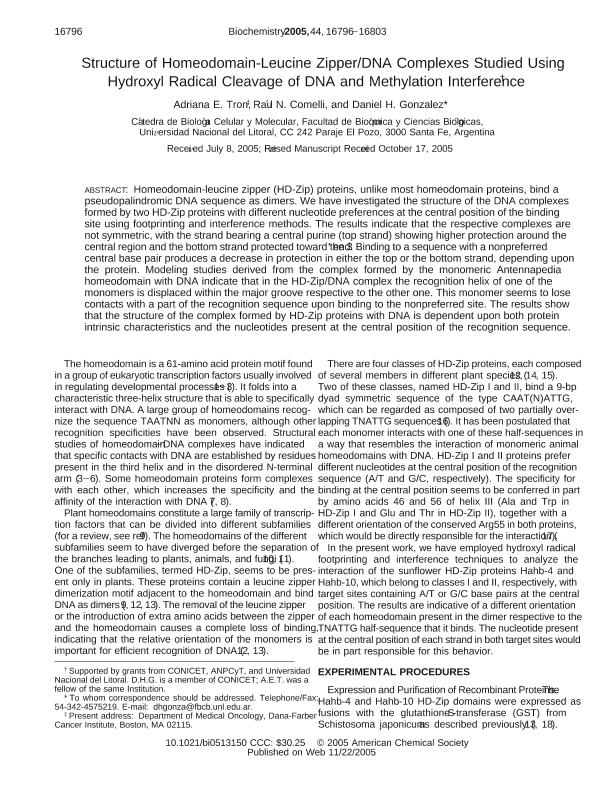Artículo
Structure of homeodomain-leucine zipper/DNA complexes studied using hydroxyl radical cleavage of DNA and methylation interference
Fecha de publicación:
12/2005
Editorial:
American Chemical Society
Revista:
Biochemistry
ISSN:
0006-2960
Idioma:
Inglés
Tipo de recurso:
Artículo publicado
Clasificación temática:
Resumen
Homeodomain-leucine zipper (HD-Zip) proteins, unlike most homeodomain proteins, bind a pseudopalindromic DNA sequence as dimers. We have investigated the structure of the DNA complexes formed by two HD-Zip proteins with different nucleotide preferences at the central position of the binding site using footprinting and interference methods. The results indicate that the respective complexes are not symmetric, with the strand bearing a central purine (top strand) showing higher protection around the central region and the bottom strand protected toward the 3′ end. Binding to a sequence with a nonpreferred central base pair produces a decrease in protection in either the top or the bottom strand, depending upon the protein. Modeling studies derived from the complex formed by the monomeric Antennapedia homeodomain with DNA indicate that in the HD-Zip/DNA complex the recognition helix of one of the monomers is displaced within the major groove respective to the other one. This monomer seems to lose contacts with a part of the recognition sequence upon binding to the nonpreferred site. The results show that the structure of the complex formed by HD-Zip proteins with DNA is dependent upon both protein intrinsic characteristics and the nucleotides present at the central position of the recognition sequence.
Palabras clave:
Homeodomain
,
Transcription factor
,
HD-Zip
Archivos asociados
Licencia
Identificadores
Colecciones
Articulos(IAL)
Articulos de INSTITUTO DE AGROBIOTECNOLOGIA DEL LITORAL
Articulos de INSTITUTO DE AGROBIOTECNOLOGIA DEL LITORAL
Citación
Tron, Adriana E.; Comelli, Raul Nicolas; Gonzalez, Daniel Hector; Structure of homeodomain-leucine zipper/DNA complexes studied using hydroxyl radical cleavage of DNA and methylation interference; American Chemical Society; Biochemistry; 44; 51; 12-2005; 16796-16803
Compartir
Altmétricas




